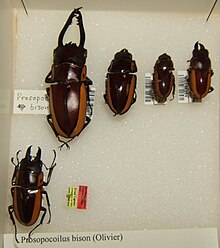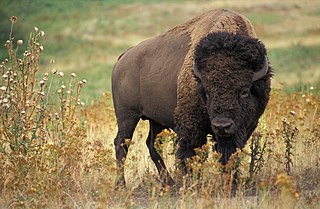
A bison is a large bovine in the genus Bison within the tribe Bovini. Two extant and numerous extinct species are recognised.

The European bison or the European wood bison, also known as the wisent, the zubr, or sometimes colloquially as the European buffalo, is a European species of bison. It is one of two extant species of bison, alongside the American bison. The European bison is the heaviest wild land animal in Europe, and individuals in the past may have been even larger than their modern-day descendants. During late antiquity and the Middle Ages, bison became extinct in much of Europe and Asia, surviving into the 20th century only in northern-central Europe and the northern Caucasus Mountains. During the early years of the 20th century, bison were hunted to extinction in the wild.

The American bison, commonly known as the American buffalo, or simply buffalo, is a species of bison that is endemic to North America. It is one of two extant species of bison, along with the European bison. Its historical range circa 9000 BC is referred to as the great bison belt, a tract of rich grassland spanning from Alaska south to the Gulf of Mexico, and east to the Atlantic Seaboard, as far north as New York, south to Georgia, and according to some sources, further south to northern Florida, with sightings in North Carolina near Buffalo Ford on the Catawba River as late as 1750.
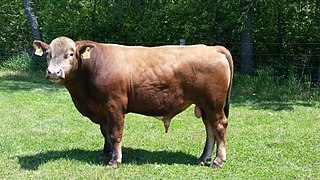
Beefalo constitutes a hybrid offspring of domestic cattle, usually a male in managed breeding programs, and the American bison, usually a female in managed breeding programs. The breed was created to combine the characteristics of both animals for beef production.

Bovines comprise a diverse group of 10 genera of medium to large-sized ungulates, including cattle, bison, African buffalo, water buffalos, and the four-horned and spiral-horned antelopes. The members of this group are classified into loose tribes rather than formal subgroups, as the evolutionary relationships within the groups are still uncertain. General characteristics include cloven hooves and usually at least one of the sexes of a species having true horns. The largest extant bovine is the gaur.
In biology, trinomial nomenclature is the system of names for taxa below the rank of species. These names have three parts. The usage is different in zoology and botany.

The Buffalo Bisons are a Minor League Baseball team of the International League and the Triple-A affiliate of the Toronto Blue Jays. Located in Buffalo, New York, the team plays their home games at Sahlen Field, the highest-capacity Triple-A ballpark in the United States.
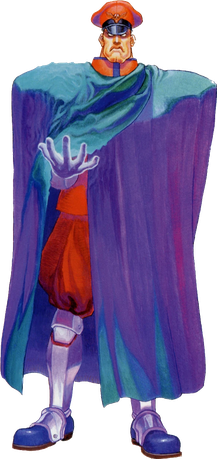
M. Bison, also known as Vega, is a fictional character created by Capcom. First introduced in Street Fighter II: The World Warrior as the final boss of the game, he is a recurring character in the Street Fighter series of fighting games, acting as one of the series' main antagonists.

Plains Indians or Indigenous peoples of the Great Plains and Canadian Prairies are the Native American tribes and First Nation band governments who have historically lived on the Interior Plains of North America. While hunting-farming cultures have lived on the Great Plains for centuries prior to European contact, the region is known for the horse cultures that flourished from the 17th century through the late 19th century. Their historic nomadism and armed resistance to domination by the government and military forces of Canada and the United States have made the Plains Indian culture groups an archetype in literature and art for Native Americans everywhere.

The North Dakota State Bison football program represents North Dakota State University in college football at the NCAA Division I Football Championship Subdivision level and competes in the Missouri Valley Football Conference. The Bison play in the 19,000-seat Fargodome located in Fargo. The Bison have won 17 national championships and 37 conference championships. They have won nine NCAA Division I AA FCS National Championships between 2011 and 2021. The Bison hold the record for most overall NCAA national championships and the record for the most consecutive championships with five titles between 2011 and 2015 for Division I FCS.

"Buffalo buffalo Buffalo buffalo buffalo buffalo Buffalo buffalo" is a grammatically correct sentence in English that is often presented as an example of how homonyms and homophones can be used to create complicated linguistic constructs through lexical ambiguity. It has been discussed in literature in various forms since 1967, when it appeared in Dmitri Borgmann's Beyond Language: Adventures in Word and Thought.

Prosopocoilus astacoides is a beetle of the family Lucanidae. It lives 8–10 months and is around 50–70 mm. Like all beetles in the Prosopocoilus genus they have sharp mandibles it uses for fighting. They will shake their antenna when angry.

Prosopocoilus biplagiatus is a beetle of the Family Lucanidae. Size of males: 18 – 39 mm, females: 18 – 25 mm.

Prosopocoilus savagei is a beetle of the Family Lucanidae. It is found in Central and East Africa. It measures about 24–65 mm in males and 21–31 mm in females.
The Lucanidae are a family of beetles that include the stag beetles. The family can be further subdivided in a taxonomy. The classification presented here follows Smith (2006), with the exception of the tribal classification within the Lucaninae.
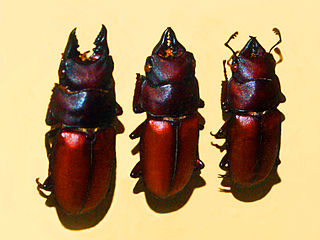
Prosopocoilus antilope is a species of beetles of the family Lucanidae.

Prosopocoilus is a genus of beetles of the family Lucanidae.

Prosopocoilus tragulus is a species of beetle in the family Lucanidae.

Prosopocoilus buddha is a species of stag beetle in the tribe Cladognathini. This Asian species is variable, with several known subspecies and widely distributed from India to Sulawesi.
Prosopocoilus bison buruensis is a subspecies of beetle from the Lucanidae family.
